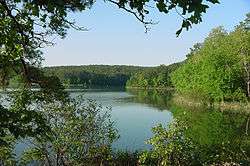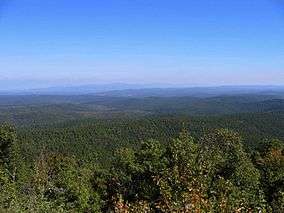Ouachita National Forest
| Ouachita National Forest | |
|---|---|
|
IUCN category VI (protected area with sustainable use of natural resources) | |
|
Ouachita National Forest | |
 | |
| Location | Arkansas / Oklahoma, United States |
| Nearest city | Hot Springs, AR |
| Coordinates | 34°30′N 94°15′W / 34.5°N 94.25°WCoordinates: 34°30′N 94°15′W / 34.5°N 94.25°W |
| Area | 1,784,457 acres (7,221 km2) |
| Established | December 18, 1907 |
| Governing body | U.S. Forest Service |
| Website | Ouachita National Forest |
The Ouachita National Forest is a National Forest that lies in the western portion of Arkansas and portions of eastern Oklahoma.
History
The Ouachita National Forest is the oldest National Forest in the southern United States. The forest encompasses 1,784,457 acres (7,221 km2), including most of the scenic Ouachita Mountains. Six locations in the forest, comprising 65,000 acres (263 km2), have been designated as wilderness areas.
Ouachita is the French spelling of the Indian word Washita, which means "good hunting grounds." The forest was known as Arkansas National Forest on its establishment on December 18, 1907; the name was changed to Ouachita National Forest on April 29, 1926.[1]

Rich in history, the rugged and scenic Ouachita Mountains were first explored in 1541 by Hernando de Soto's party of Spaniards. French explorers followed, flavoring the region with names like Fourche La Fave River.
The area including the forest nearly became a 165,000-acre (670 km2) national park during the 1920s, but a last-minute pocket veto by U.S. President Calvin Coolidge ended the effort. The bill had been pushed by U.S. Senator Joseph T. Robinson and U.S. Representative Otis Wingo, both Democrats, and State Representative Osro Cobb, then the only Republican in the Arkansas legislature. Cobb had been invited to meet with Coolidge before the proposal was killed because of opposition from the National Park Service and the United States Department of Agriculture,[2] presumably because of the nearby location of Hot Springs National Park.
In a magazine article, Cobb describes the area that he had sought to protect for future generations, located approximately midway between Little Rock and Shreveport, Louisiana, as within relatively easy driving distance of 45 million Americans, many of whom could not afford long trips to the national parks in the western states. He compared flora and fauna in the Ouachita forest to those of the southern Alleghenies, a division of the Appalachian Mountains.[3] Cobb continues:
A visitor standing upon one of the many majestic peaks in the area of the proposed park is thrilled by a panoramic view that cannot be had elswwhere [sic] in the South Central States. With cheeks flushed by the invigorating mountain beezes, the mountain climber is rewarded by an inspring [sic] view of countless and nameless peaks, mountain groups, dense forests, and inviting valleys, all merging into the distant horizon. ... there are many mountain streams, now moving slowly in narrow but deep pools, then churning with savage ferocity down some water-worn precipice, leaving in its wake snow-white sprays ... Fed by crystal springs and like so much molten silver these streams flow their turbulent courses unappreciated and rarely visited. ...[4]
Features
The Forest contains extensive woodlands of stunted Northern Red Oak, White Oak, Post Oak, and Blackjack Oak at elevations over 2,500 feet (760 m) and on steep, dry slopes.[5] These woodlands, of little commercial value, were never logged and the extent of old growth forest within them may total nearly 800,000 acres (3,200 km2).[5] There are also old-growth woodlands of Eastern Redcedar, Gum Bumelia, Winged Elm, and Yaupon along some streams.[5]
Two wilderness areas are found in the forest, protecting the sections of the forest that have had the least amount of human intervention. The 13,139-acre (53.2 km2) Black Fork Mountain Wilderness is located in both Arkansas and Oklahoma and contains significant old-growth forests.[5] The 9,754-acre (39.5 km2) Upper Kiamichi River Wilderness is located solely in Oklahoma.
The Talimena Scenic Drive, which is Highway 1 in Oklahoma and Highway 88 in Arkansas, is a National Scenic Byway which meanders through the forest providing amazing vistas and excellent photo opportunities. The Scenic Drive passes through old-growth oak woodlands on Winding Stair and Rich Mountains.[5] Forest headquarters are located in Hot Springs, Arkansas.
Recreation
The forest contains a number of hiking, mountain biking, and horseback riding trails. The most extensive hiking trail is the Ouachita National Recreation Trail, which traverses 223 miles (359 km) across the region. This is a well-maintained backpacking, hiking trail with overnight shelters in several portions of the trail. Mountain biking is also allowed for some sections of the trail.
In the Oklahoma section of the forest the 26,445-acre (107 km2) Winding Stair Mountain National Recreation Area and six other designated areas offer visitors a full range of activities with more than 150 campsites, a 90-acre (36 ha) lake, and an equestrian camp.
Southeast of Idabel, the Oklahoma Department of Wildlife Conservation manages the Red Slough Wildlife Mananagement Area, a 5,814 acres (23.53 km2) wetland area donated to the USFS by The Conservation Fund in the late 1990s and early 2000s. Hunting (no lead shot) and fishing are allowed there. The area is also a destination for birdwatchers from throughout the United States and the United Kingdom as well.
Canoeing and fishing are popular activities on the Mountain Fork River, Caddo River, Little Missouri River, and Ouachita River within the bounds of the forest. The Cossatot River, said to be the most difficult whitewater river between the Smoky and Rocky Mountains, also passes through the forest.
Rockhounds frequent a belt several miles wide containing concentrations of quartz crystals. Visitors and rock collectors are free to pick up loose crystals within the belt for personal use and may dig for quartz with the permission of the district ranger.
Counties
Ouachita National Forest is located in 13 counties in western and central Arkansas and 2 counties in southeastern Oklahoma. They are listed here in descending order of forestland within the county. Also given is their area as of September 30, 2007.[6] About 80% of the forest's area is in Arkansas, with the remaining 20% in Oklahoma. In Arkansas there are local ranger district offices located in Booneville, Danville, Glenwood, Jessieville, Mena, Mount Ida, Oden, Perryville, and Waldron. In Oklahoma they are located in Hodgen, Talihina, and north of Broken Bow. Even though the Ouachita National Forest is far from being the largest, its twelve ranger districts are the most of any in the National Forest system. The giant Tongass National Forest in Alaska is second with nine ranger district divisions.[7]
- Scott County, Arkansas 369,618 acres (1,495.79 km2)
- Montgomery County, Arkansas 335,846 acres (1,359.12 km2)
- Le Flore County, Oklahoma 221,546 acres (896.56 km2)
- Polk County, Arkansas 206,400 acres (835 km2)
- Yell County, Arkansas 188,835 acres (764.19 km2)
- McCurtain County, Oklahoma 132,936 acres (537.97 km2)
- Garland County, Arkansas 120,553 acres (487.86 km2)
- Perry County, Arkansas 99,171 acres (401.33 km2)
- Saline County, Arkansas 58,950 acres (238.6 km2)
- Sebastian County, Arkansas 18,956 acres (76.71 km2)
- Logan County, Arkansas 18,585 acres (75.21 km2)
- Pike County, Arkansas 9,535 acres (38.59 km2)
- Ashley County, Arkansas 1,675 acres (6.78 km2)
- Howard County, Arkansas 1,531 acres (6.20 km2)
- Hot Spring County, Arkansas 320 acres (1.3 km2)
Points of interest
- Beavers Bend Resort Park
- Beech Creek National Scenic Area
- Broken Bow Lake
- Kerr Arboretum and Botanical Area
- Ouachita National Recreation Trail
- Winding Stair Mountain National Recreation Area
Wilderness areas
There are six officially designated wilderness areas lying within Ouachita National Forest that are part of the National Wilderness Preservation System.
- Black Fork Mountain Wilderness
- Caney Creek Wilderness
- Dry Creek Wilderness
- Flatside Wilderness
- Poteau Mountain Wilderness
- Upper Kiamichi River Wilderness
See also
References
- ↑ Davis, Richard C. (September 29, 2005). "National Forests of the United States" (PDF). The Forest History Society.
- ↑ Osro Cobb, Osro Cobb of Arkansas (Little Rock, Arkansas: Rose Publishing Company, 1989), pp. 41–44
- ↑ Cobb, p. 282
- ↑ Cobb, p. 285
- 1 2 3 4 5 Mary Byrd Davis (23 January 2008). "Old Growth in the East: A Survey. Arkansas" (PDF).
- ↑ "Table 6 - NFS Acreage by State, Congressional District and County". fs.fed.us. 10 October 2007. Retrieved 12 March 2016.
- ↑ USFS Ranger Districts by State
External links
| Wikimedia Commons has media related to Ouachita National Forest. |
